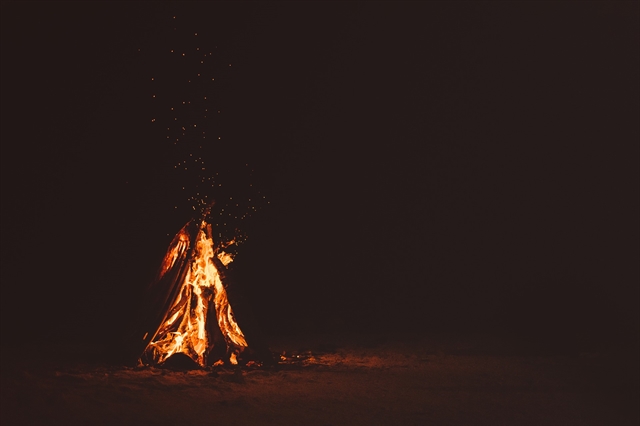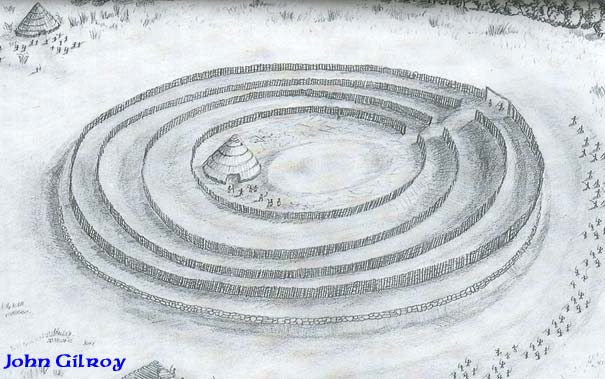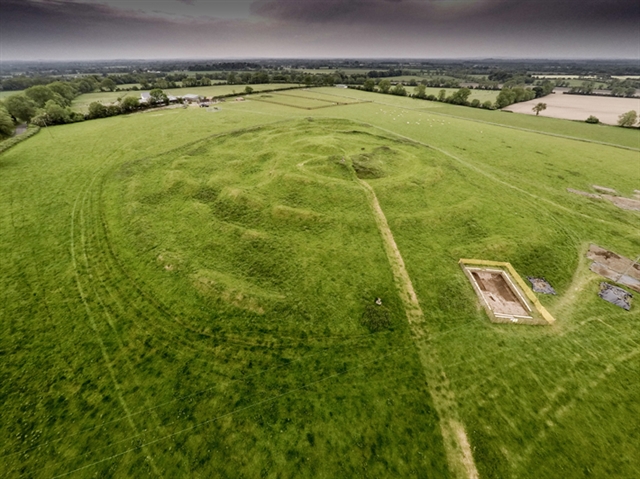
Samhain (sow-in)
November 1st was traditionally known as Samhain, literally translated, the "end of summer." October 31st marked the end of the Celtic year, the start of winter and a time for reflection.
On this day, it was said that a person’s ancestors would walk through the furze of time and shadows and come back to visit. People would disguise themselves in costume so their long-gone relatives would not recognize them and possibly impose upon them, or try to take them onto the other side.
The early blackness of the night was frightening to people, and the lack of light only offered up the familiarity of lurking spectres.
Samhain was also when meetings were held, wars were stopped, and peace was made. It was a time to take stock and decide upon future activities. All debts had to be settled and horse-racing as well as chariot racing gave parties the chance for entertaining diversions.
Traditionally, all the fires were extinguished when Oiche Shamhna, (Samhain day) set in, making this the darkest night of the year. The fires were then re-lit, marking the start of the new year.

In ancient Ireland, the Hills of Tara and Tlachtga were important. Tara was long the seat of the High Kings of Ireland (photo above is the hill of Tara).
Tradition has it that druids lit a huge bonfire on the Hill of Tlachtga (near Athboy, County Meath) and burning torches were then carried from there to every household during the night. The hill of Tlachtga is about thirteen miles away from the hill of Tara.
The ancient ritual site of Tlachtga was the center of Celtic religious worship over two thousand years ago. It has been overshadowed by its famous neighbor and has not received the attention it merits as a place of importance in its own right. This was the center of the Great Fire Festival that signaled the onset of winter.
Great Fire Festival
The rituals and ceremonies carried out here by the pre-Christian Irish offered assurances to the people that the powers of darkness would be overcome, and the powers of light and life would, once again, be in the ascendancy. This was the place where the Celtic sun god was celebrated at the year's end.
The festival probably lasted for at least several days and centered on the god Lugh. The site takes it name from Tlachtga (pronounced Clackda), the daughter of the Druid Mug Ruith who died there giving birth to triplets. Tlachtga is clearly visible from Tara and the fire lit on the eve of Samhain was a prelude to the Samhain Festival at Tara.
With the coming of Christianity, the festival was incorporated into the Christian calendar as a time of remembrance for the holy souls, so the Samhain festival of the ancestors retained its relevance. The customs of Samhain that didn't fit into Christianity survived as Halloween. Irish immigrants carried the Halloween tradition to North America in the 19th century.

Tlachtga (photo above is the hill of Ward)
Tlachtga was an interesting character in her own right. Tlachtga accompanied her father, the Druid Mug Ruith, on his world travels, learning his magical secrets and discovering sacred stones in Italy. They flew in a machine called the roth ramach, the "oared wheel." She gave birth to triplets called Cumma, Doirb and Muach, issued from 3 different fathers. They were born on the hill that would later bear the name of their mother. The triple birth is a common theme in Celtic mythology, and her death of grief and the construction of a fortress at her grave echoes the story of Macha, from Navan, in Armagh.
It is believed that the tribe that introduced the cult of Tlachtga as a fertility Goddess to this area were the Luigni, an Erainn tribe. They were partially displaced by a new wave of invaders known as the Lagin. They took over the Kingship of Tara and the focus of power shifted from Tlachtga and became centered on Tara.
The Hill of Tlachtga is also known as the Hill of Ward. The ringfort built on the hill was associated not only with the kings of Mide, but also with Munster as well, travelling a bit afield, as it were.
The ard ri, (high king) Ruaidri Ua Conchobair (Rory O'Connor) held a massive assemblage in 1168 at the site, as well. Mug Ruith (or Mogh Roith, "slave of the wheel") was a larger than life blind druid of Munster who lived on Valentia Island, County Kerry. He could grow to enormous size, and his breath caused storms and turned men to stone. He wore a hornless bull-hide and a bird mask. He had an ox-driven chariot in which night was as bright as day, a star-speckled black shield with a silver rim, and a stone which could turn into a poisonous eel when thrown in water.
He was also said to be the executioner of John the Baptist, even though he supposedly died in 2500 BC. The territory Mug Ruith received for his descendants was Fir Maige Fene, later known as Fermoy. The medieval tribe of Fir Maige Fene claimed descent from him.

The Remains of the Hill of Ward
The earthworks seen on the Hill of Ward today represent the last phase of development about 2000 years ago. The remains of an older barrow burial have been incorporated in the earthworks. It is likely that the hill was the centre of ritual activity long before the Celtic period.
The hill got its English name from a landowner, Ward, who had been evicted from his land during the invasion of Oliver Cromwell in 1649. The land was given to a Roundhead soldier. The Ward family, whose forebears were landowners of the hill and of whom the hill was named after, are living in County Meath today. The Ward family, of Milwaukee Irish Fest, are also amongst the descendants of that long ago Mr. Ward.
Recently, Irish archaeologists digging at Tlachtga - the Hill of Ward - have found evidence of intense burning at the site dating back to 500 AD. In 2014, excavation found the skeleton of a child buried in one of the chambers. Dr. Steve Davis, from UC Dublin, was one of the people working the site.
“There has been a suggestion that one of the reasons the site is not better known is that it was written out of the Patrick story - that it was so infamous that the church did a very good job of trying to erase it from the mythology," Dr. Davis said.
The site has found renewed interest in the past few years, with torchlight parades up to the top of the hill on Samhain. We have traveled across time and hills, goddesses and magical druids, from Munster to Meath, and into the dark and back to the light, from the old year to the new year, and from the dead to the living.
I hope it has been an enjoyable journey, crossing these byroads in the Samhain celebration, and some of the stories of its background.
Just remember, if you don’t want to be recognized by your long ago, across the spirit world family, dress in costume. They may be looking for money.
(You can find out more about the light festival in John Gilroy’s wonderful book, “Tlachtga: Celtic Fire Festival.” It was published by Pikefield Publications, 9 Hazelwood Court, Glanmire, Co. Cork in October 2000. It is available on Amazon.)